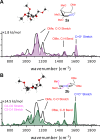Direct Experimental Characterization of Glycosyl Cations by Infrared Ion Spectroscopy
- PMID: 29656643
- PMCID: PMC5958338
- DOI: 10.1021/jacs.8b01236
Direct Experimental Characterization of Glycosyl Cations by Infrared Ion Spectroscopy
Abstract
Glycosyl cations are crucial intermediates formed during enzymatic and chemical glycosylation. The intrinsic high reactivity and short lifetime of these reaction intermediates make them very challenging to characterize using spectroscopic techniques. Herein, we report the use of collision induced dissociation tandem mass spectrometry to generate glycosyl cations in the gas phase followed by infrared ion spectroscopy using the FELIX infrared free electron laser. The experimentally observed IR spectra were compared to DFT calculated spectra enabling the detailed structural elucidation of elusive glycosyl oxocarbenium and dioxolenium ions.
Conflict of interest statement
The authors declare no competing financial interest.
Figures





Similar articles
-
Characterization of Elusive Reaction Intermediates Using Infrared Ion Spectroscopy: Application to the Experimental Characterization of Glycosyl Cations.Acc Chem Res. 2022 Jun 21;55(12):1669-1679. doi: 10.1021/acs.accounts.2c00040. Epub 2022 May 26. Acc Chem Res. 2022. PMID: 35616920 Free PMC article. Review.
-
Glycosyl Oxocarbenium Ions: Structure, Conformation, Reactivity, and Interactions.Acc Chem Res. 2021 Jun 1;54(11):2552-2564. doi: 10.1021/acs.accounts.1c00021. Epub 2021 Apr 30. Acc Chem Res. 2021. PMID: 33930267 Free PMC article. Review.
-
Characterization of Cyclic N-Acyliminium Ions by Infrared Ion Spectroscopy.Chemistry. 2022 Feb 16;28(9):e202104078. doi: 10.1002/chem.202104078. Epub 2021 Dec 29. Chemistry. 2022. PMID: 34911145 Free PMC article.
-
Infrared ion spectroscopy in a modified quadrupole ion trap mass spectrometer at the FELIX free electron laser laboratory.Rev Sci Instrum. 2016 Oct;87(10):103108. doi: 10.1063/1.4964703. Rev Sci Instrum. 2016. PMID: 27802712
-
Characterization of elusive rhamnosyl dioxanium ions and their application in complex oligosaccharide synthesis.Nat Commun. 2024 Mar 13;15(1):2257. doi: 10.1038/s41467-024-46522-2. Nat Commun. 2024. PMID: 38480691 Free PMC article.
Cited by
-
Stereoelectronic Effect of Protecting Groups on the Stability of Galactosyl Donor Intermediates.Molecules. 2025 Jan 7;30(2):218. doi: 10.3390/molecules30020218. Molecules. 2025. PMID: 39860088 Free PMC article.
-
Acetal Substitution Reactions: Stereoelectronic Effects, Conformational Analysis, Reactivity vs. Selectivity, and Neighboring-Group Participation.Synlett. 2024 Sep;35(15):1763-1787. doi: 10.1055/s-0042-1751541. Epub 2024 Jan 16. Synlett. 2024. PMID: 39502501 Free PMC article.
-
The Influence of the Electron Density in Acyl Protecting Groups on the Selectivity of Galactose Formation.J Am Chem Soc. 2022 Nov 9;144(44):20258-20266. doi: 10.1021/jacs.2c05859. Epub 2022 Oct 26. J Am Chem Soc. 2022. PMID: 36289569 Free PMC article.
-
Degradation of Lignin by Infrared Free Electron Laser.Polymers (Basel). 2022 Jun 14;14(12):2401. doi: 10.3390/polym14122401. Polymers (Basel). 2022. PMID: 35745977 Free PMC article.
-
En Route to the Transformation of Glycoscience: A Chemist's Perspective on Internal and External Crossroads in Glycochemistry.J Am Chem Soc. 2021 Jan 13;143(1):17-34. doi: 10.1021/jacs.0c11106. Epub 2020 Dec 22. J Am Chem Soc. 2021. PMID: 33350830 Free PMC article.
References
-
- Horenstein N. A. In Advances in Physical Organic Chemistry; Richard J. P., Ed.; Elsevier: New York, 2006; Vol. 41, p 275.
Publication types
LinkOut - more resources
Full Text Sources
Other Literature Sources

